#Louise Charlotte of Mecklenburg-Schwerin
Explore tagged Tumblr posts
Photo

Duchess Louise Charlotte of Mecklenburg-Schwerin (19 November 1779 – 4 January 1801) was the maternal grandmother of Prince Albert, husband of Queen Victoria of the United Kingdom.
Louise Charlotte was born Duchess of Mecklenburg-Schwerin, her father being Friedrich Franz I, Grand Duke of Mecklenburg-Schwerin. Her mother was Princess Louise of Saxe-Gotha-Altenburg; her sister Charlotte of Mecklenburg-Schwerin (1784–1840) married King Christian VIII of Denmark.
#Louise Charlotte of Mecklenburg-Schwerin#House Mecklenburg-Schwerin#XVIII century#XIX century#people#portrait#paintings#art#arte
28 notes
·
View notes
Text

Friedrich Franz Michael IV, Grand Duke of Mecklenburg-Schwerin with his children: Friedrich Franz, Hereditary Grand Duke of Mecklenburg-Schwerin Duke Christian-Ludwig of Mecklenburg-Schwerin Duchess Thyra Anastasia Alexandrine Marie-Louise Olga Cecilie Charlotte Elisabeth Emma of Mecklenburg-Schwerin
German vintage postcard
#tarjeta#louise#postkaart#sepia#cecilie#christian-ludwig#friedrich#duke#duchess#michael#schwerin#carte postale#olga#hereditary#charlotte#ansichtskarte#children#grand#ludwig#german#briefkaart#mecklenburg#elisabeth emma#elisabeth#photo#photography#emma#postal#postkarte#alexandrine marie-louise olga cecilie
3 notes
·
View notes
Text






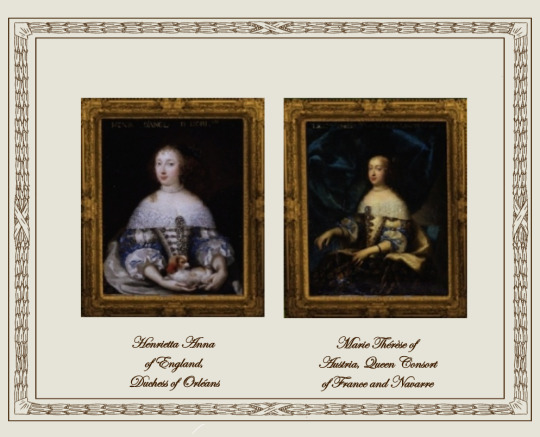
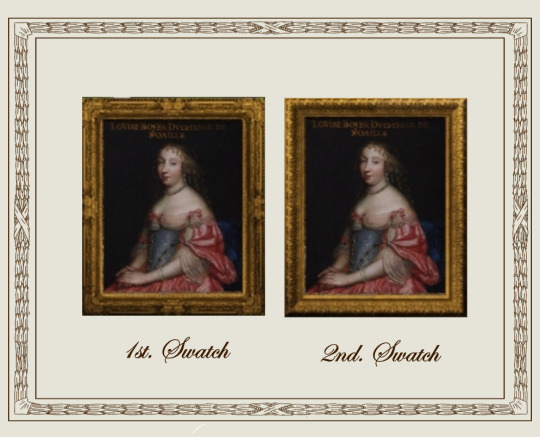
Louis XIV's Gallery of Beauties
A retexture by La Comtesse Zouboff — Original Mesh by @thejim07
This set of 20 portraits was comissioned by the king himself in the 1650s to Charles and Henri Beaubrun (except for a portrait of Henrietta Anna of England, Comissioned to Nicolas Mignard) The portraits comprises the queen, royal princesses and ladies of the court. They hanged at the king's appartments at Versailles. In the 1670s the paintings were progressively relegated to the king's minor residences, but in 1837, Louis-Philippe, King of the French turned Versailles into a museum and rejoined the paintings, in the Louis XIV Rooms, where they remain.
The set includes 20 portraits, with the original frame swatches, fully recolorable. The portraits are of:
Anne Genèvieve de Bourbon, Duchess d'Estouteville and Longueville
Françoise-Athénaïs de Rochechouart (later, Marquise de Montespan)
Anna Martonozzi, Princess of Conti
Anne Louise Boyer, Duchess of Noailles
Anne Marie Gonzaga, Countess Palatine
Anne de Rohan-Chabot, Princess de Soubise
Catherine Henriette d'Harcourt, Duchess d'Arpajon
Catherine de Neuville, Countess d'Armagnac
Charlotte Catherine de Gramont, Proncess of Monaco
Charlotte Isabelle Angélique de Montmorency-Bouteville, Duchess of Mecklenburg-Schwerin
Elizabeth of Orléans, Duchess of Guise and Joÿeuse
Françoise Madeleine d'Orléans (née de Valois) Duchess of Savoy
Françoise Mignot, Mareschalle of l'Hospital
Françoise de Neufville, Duchess of Chaulnes
Gabrielle-Louise de Saint-Simon, Duchess of Brissac
Henrietta Anna of England, Duchess of Orléans
Madeleine-Charlotte d'Albert-d'Ailly, Duchess of Foix
Marguerite Louise d'Orléans, Grand Duchess of Tuscany
Marguerite-Louise-Suzanne de Béthune-Sully, Countess of Gyche
Marie Thérèse of Austria, Queen Consort of France and Navarre
Found under Decor > Paintings for 940 §
Retextured from the "portrait of Anne Marie Louise d'Orléans", found here
Table, torcheres and floor by @thejim07
Rest of the decor by @joojconverts

Drive
(Sims3pack | package)
(Useful tags)
@joojconverts @ts3history @ts3historicalccfinds @deniisu-sims @katsujiiccfinds
-------------------------------------------------------
#the sims 3#ts3#sims 3 cc#portrait#s3cc#sims 3#sims 3 download#sims 3 cc finds#palace of versailles#sims 3 decor#wall decor
43 notes
·
View notes
Text




Maternal grandmother of Albert, Prince Consort.
Duchess Louise Charlotte of Mecklenburg-Schwerin, Hereditary Princess of Saxe-Gotha-Altenburg.
In Ludwigslust on 21 October 1797 she married Augustus, Hereditary Prince of Saxe-Gotha-Altenburg, a second cousin on her mother's side. Their common ancestor was Frederick II, Duke of Saxe-Gotha-Altenburg. The marriage was arranged against her will and was an unhappy one: her spouse abused her and she wished to leave him, but was forced by her family to stay.
She was described as very blond, not attractive, somewhat hunchbacked but also as witty, talented, cultivated and with a pleasant manner, though more open than what was regarded as an ideal for the period.
Three years later, on 21 December 1800 in Friedenstein Castle around 12.45 pm[3] the Hereditary Princess of Saxe-Gotha-Altenburg gave birth her only child, a daughter, named Louise after her; this daughter later became the wife of Ernst I, Duke of Saxe-Coburg and Gotha, and mother to Prince Albert, Prince consort of Queen Victoria. However, she never recovered from childbirth effects and died eleven days later, on 1 January 1801 at the age of 21, before Augustus assumed the throne of Saxe-Gotha-Altenburg.
Three years later, on 21 December 1800 in Friedenstein Castle around 12.45 pm the Hereditary Princess of Saxe-Gotha-Altenburg gave birth her only child, a daughter, named Louise after her; this daughter later became the wife of Ernst I, Duke of Saxe-Coburg and Gotha, and mother to Prince Albert, Prince consort of Queen Victoria. However, she never recovered from childbirth effects and died eleven days later, on 4 January 1801 at the age of 21, before Augustus assumed the throne of Saxe-Gotha-Altenburg.
#duchess louise charlotte of mecklenburg-schwerin#hereditary princess louise charlotte of saxe-gotha-altenburg#saxe-gotha-altenburg#german royalty#german royal#mecklenburg-schwerin
17 notes
·
View notes
Photo

Marie Louise of Mecklenburg-Schwerin, Duchess of Saxe-Altenburg (31 March 1803 - 26 October 1862)
#marie louise of mecklenburg-schwerin#marie luise friederike alexandrine elisabeth charlotte catherine#duchess of saxe-altenburg#daughter of frederick louis hereditary grand duke of mecklenburg-schwerin#married george i duke of saxe-altenburg#history#women in history#19th century
2 notes
·
View notes
Note
What do you think of the Danish Pearl Poiré Tiaras (and brooch)? Who do you think the twin tiara might have ended up belonging to? The mystery surrounding its whereabouts is so annoying.
I feel like a little background is needed before I can answer the question so for those of you that don’t know the Pearl Poiré Tiara currently worn by Queen Margrethe II of Denmark had a twin.

I’ve never read anything specifically about the brooch or if I have then I’ve forgotten it as I tend to do with non-tiara information but it looks like there were also twin brooches. It’s interesting because the design brooch doesn’t exactly match tiara. They both have drop pearls and foliate parts but then the brooches also have scrolls and flowers. Both of the pictures below are Princess Louise’s brooch, sometimes Queen Margrethe wears it attached to a pearl necklace which frankly looks uncomfortable.

King Frederick William III of Prussia bought the first set for his daughter, Princess Louise (below left), when she married Prince Frederick of the Netherlands in 1825. Then he bought the second for his daughter-in-law, Princess Marianne of the Netherlands (below right), when she married Prince Albert in 1830. Basically one set of siblings married another set of siblings and they were all first cousins so I guess he thought that warranted matching jewelry. Princess Louise’s tiara traveled to Sweden and then ended up in Denmark where it is now.

Princess Marianne’s tiara was inherited by her youngest daughter, Princess Alexandrine, Duchess of Mecklenburg-Schwerin (below), and from there is seems to have disappeared.

Alexandrine had a daughter, Charlotte, so it’s likely that she inherited the tiara and brooch if they still existed at the time but I can’t find any pictures of her wearing them. If I had to guess I’d say they’re long gone, either made into other jewelry or sold and then made into other jewelry.
#Tiara Talk#Denmark#tiara#Princess Louise#Princess Marianne#Netherlands#Prussia#Danish Royal Family#Prussian Royal Family#Germany#German Royalty#Dutch Royal Family#Princess Alexandrine#Mecklenburg-Sherwin#brooch#Queen Margrethe II#Queen Margrethe#pearl#booo1234#tiaras#diadem#diadems#royal tiaras#jewels#royal jewels#royal#royals#royalty#jewellery#jewelry
94 notes
·
View notes
Text
Master Post - Members who married into a royal or noble house
Disclaimer: If a person married someone from the same house as they were born into, I have not listed them in this list. Please look at the list sorted by birth for them. Houses that rule(d)/reside(d) in other countries but originally came from German and/or Austrian territories and/or are generally regarded as belonging to this cultural room are listed among the German & Austrian Houses.
German & Austrian Houses
House of Babenberg
Princess Eudokia Laskarina of Nicaea, The Hereditary Duchess of Austria
Princess Theodora Angelina of Byzantium, The Duchess of Austria & Styria
Princess Theodora Komnene of Byzantium, The Duchess of Bavaria & Austria
House of Castell
Baroness Ottilie of Faber, Countess of Faber-Castell
House of Coburg (Cadet branch of the House of Wettin)
Princess Louise of Saxe-Gotha-Altenburg, The Duchess of Saxe-Coburg-Saalfeld (1st marriage)
Princess Mary of Teck, The Queen of the United Kingdom & British Dominions, The Empress of India
Queen Victoria of the United Kingdom (wife of Prince Albert of Saxe-Coburg and Gotha)
House of Faber
Ottilie Richter, Baroness of Faber
House of Habsburg (incl. Habsburg-Lorraine)
Anna Plochl, Countess of Meran
Princess Charlotte of Belgium, The Empress of Mexico, Archduchess of Austria
Infanta Eleanor of Portugal, Holy Roman Empress, The Archduchess of Austria
Eleonore Magdalene of Neuburg, Holy Roman Empress
Elisabeth in Bavaria, The Empress of Austria
Princess Elisabeth Christine of Brunswick-Wolfenbüttel, Holy Roman Empress
Queen Joanna of Castile, León and Aragon (Consort of Philip the Handsome, Archduke of Austria and The Duke of Burgundy)
Princess Maria Anna of Bavaria, The Archduchess of Inner Austria-Styria
Maria Beatrice d’Este, The Duchess of Massa & Carrara, Archduchess of Austria
Mary, The Duchess of Burgundy
Princess Sophie of Bavaria, Archduchess of Austria
Countess Sophie Chotek of Chotkowa and Wognin, The Duchess of Hohenberg
Princess Stéphanie of Belgium, The Crown Princess of Austria, Hungary and Bohemia
House of Hanover (Cadet branch of the House of Welf)
Princess Adelaide (Adelheid) of Saxe-Meiningen, The Queen of the United Kingdom and Hanover
Princess Caroline of Ansbach, The Queen of Great Britain
Princess Caroline of Brunswick-Wolfenbüttel, The Queen of the United Kingdom and Hanover
Princess Charlotte of Mecklenburg-Strelitz, The Queen of Great Britain, Ireland and Hanover
Frederica (Friederike) of Mecklenburg-Strelitz, The Queen of Hanover, The Duchess of Cumberland and Teviotdale (3rd marriage)
Princess Victoria of Saxe-Coburg-Saalfeld, The Duchess of Kent (2nd marriage)
House of Hesse
Princess Alice of Great Britain and Ireland, The Grand Duchess of Hesse and by Rhine
Princess Cecilie of Greece and Denmark, The Hereditary Grand Duchess of Hesse and by Rhine
Princess Christina of Saxony, The Landgravine of Hesse
House of Hohenlohe-Langenburg
Princess Feodora of Leininigen, The Princess of Hohenlohe-Langenburg
House of Hohenstaufen
Irene of Byzantium, The Queen of the Germans, The Duchess of Swabia
House of Hohenzollern
Princess Augusta of Saxe-Weimar-Eisenach, The German Empress
Princess Augusta Victoria (Auguste Viktoria) of Schleswig-Holstein, The German Empress
Elisabeth Christine of Brunswick-Wolfenbüttel-Bevern, The Queen of Prussia
Princess Elisabeth of Wied, The Queen & Princess of Romania
Princess Elisabeth Ludovika of Bavaria, The Queen of Prussia
Frederica (Friederike) of Mecklenburg-Strelitz, Princess Louis Charles of Prussia (1st marriage)
Princess Hermine Reuß, “German Empress”
Jadwiga Jagiellon, Electress of Brandenburg
Louise of Mecklenburg-Strelitz, The Queen of Prussia
Princess Sophia Dorothea of Hanover, The Queen in Prussia
Princess Victoria of Great Britain and Ireland, Princess Royal, The German Empress
House of La Marck
Jeanne d’Albret, The Duchess of Jülich-Cleves-Berg
House of Limburg-Luxemburg
Elizabeth of Pomerania, Holy Roman Empress
House of Nassau
Princess Sophie of Württemberg, The Queen of the Netherlands
House of Oldenburg
Princess Adelheid of Hohenlohe-Langenburg, The Duchess of Schleswig-Holstein
Princess Juliane of Brunswick-Wolfenbüttel-Bevern, The Queen of Denmark and Norway
House of Supplinburg
Richenza of Northeim, Holy Roman Empress
House of Thurn and Taxis
Helene in Bavaria, The Hereditary Princess of Thurn and Taxis
House of Welf (without the British Hanover branch)
Princess Elisabeth of Brandenburg, The Duchess of Brunswick-Calenberg-Göttingen
Elisabeth of Mecklenburg-Schwerin, Princess of Brunswick-Lüneburg aka Grand Duchess Anna Leopoldovna of Russia
House of Wettin (without the Coburg branch)
Princess Amalie Auguste of Bavaria, The Queen of Saxony
Princess Feodora of Hohenlohe-Langenburg, The Duchess of Saxe-Meiningen
Princess Maria Anna of Bavaria, The Queen of Saxony
Sibylle of Cleves, The Electress of Saxony
House of Wittelsbach
Elizabeth Stuart, The Queen of Bohemia & Electress Palatine
Kunigunde of Austria, The Duchess of Bavaria-Munich
Princess Louise d’Orléans, Princess of Bavaria
Archduchess Maria Antonia of Austria, The Electress of Bavaria
Princess Marie of Prussia, The Queen of Bavaria
The House of Württemberg
Princess Antoinette of Saxe-Coburg-Saalfeld, Duchess of Württemberg
Princess Marie Auguste of Thurn and Taxis, The Duchess of Württemberg
The Ottonians
Adelaide of Burgundy, Holy Roman Empress, Queen of Italy
Theophanu, Holy Roman Empress
Foreign Houses
House of Bourbon
Jeanne d’Albret, The Queen of Navarre and The Duchess of Vendôme
Archduchess Maria Antonia “Marie Antoinette” of Austria, The Queen of France
House of Braganza
Archduchess Maria Leopoldina, The Empress of Brazil, The Queen of Portugal and the Algarves
Byzantine Imperial Family
Konstanze “Anna” of Hohenstaufen, The Empress of Nicaea
House of Ivrea
Elisabeth “Beatrix” of Swabia, The Queen of Castile, León & Galicia
House of Lorraine
Archduchess Maria Anna of Austria, Princess of Lorraine and Bar
The Archduchess Maria Theresa (Maria Theresia) of Austria, Holy Roman Empress (marriage formed new House of Habsburg-Lorraine)
House of Medici
Archduchess Johanna of Austria, The Grand Duchess of Tuscany
House of Radziwiłł
Princess Luise of Prussia, Princess Radziwiłł
House of Romanov (incl. Romanov-Holstein-Gottrop)
Princess Alix of Hesse and by Rhine aka Empress Alexandra Feodorovna of Russia
Princess Elisabeth of Hesse and by Rhine, Grand Duchess Elizabeth Feodorovna of Russia
Princess Sophie of Anhalt-Zerbst, The Empress Regnant of Russia aka Catherine the Great
House of Tudor
Anne of Cleves, The Queen of England
House of Valois
Elisabeth (Isabeau) of Bavaria, The Queen of France
House of Vasa
Princess Maria Eleonora of Brandenburg, The Queen of Sweden
Minor Nobles
Anna Constantia of Brockdorff, The Imperial Countess of Cosel
Helene Baltazzi, The Baroness of Vetsera
Maria Anna Mozart, The Imperial Countess Berchthold
Marie Karoline of Mollard, The Imperial Countess of Fuchs to Bimbach
Sophia Botta, The Dark Countess of Hildburghausen
Sophie of Pannwitz, Countess of Voß
58 notes
·
View notes
Text
German(-Russian) nobles in period dramas!
@germanaustriannoblesandroyals I’m responding to this post in which you asked if anyone knew of various portrayals of German nobles, including those who married into German noble families. (But also for the potential benefit of my own followers. I don’t know how helpful any of these will be for making gifs and whatnot as I know far from all of them have subs.) Luckily, the Russian royal family starting with the mid-18th century is a goldmine for German nobility; and, luckily too, Russia loves making period dramas about the Romanovs. (For ease, I’m gonna go in chronological order here.)
Anna Petrovna
A daughter of Peter the Great, she married Karl Friedrich, Duke of Holstein-Gottorp. Both Anna and her husband are portrayed in the first and second movies of the Secrets of the Palace Revolutions movie cycle, “The Emperor’s Will” and “The Empresses’ Will.”
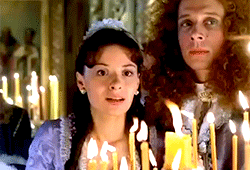
Elisabeth Katharina Christine von Mecklenburg-Schwerin (Anna Leopoldovna)
Born the daughter of a German duke, (and later married another German Duke, Anthony Ulrich of Brunswick) she was the mother and regent of Russian Emperor Ivan IV until he was deposed in a coup d’etat. She is portrayed in the final film of the Secrets of the Russian Revolutions cycle, Okhota Na Princessu (Hunting a Princess).

Her husband, Anton Ulrich, is also portrayed in that film, as well as in the tv series Ekaterina.

Karl Peter von Holstein-Gottorp (Peter III Fyodorovich)
The Russian Emperor Peter III was born Duke of Holstein-Gottorp. There are several portrayals of him, the best one (IMO) being the tv series Ekaterina. (His wife, Catherine, was a German princess, but I saw that you already made a gifset of her.)

Also, interestingly (and kind of amazingly) Ekaterina also portrays Peter’s senior chamberlain, Christian August von Brockdorff, a member of a prominent Holstein noble family, who was one of Peter III’s favorites, especially in the mid 1750s.

Wilhelmina Luisa von Hessen-Darmstadt (Natalia Alekseyevna)
Paul I’s first wife was the daughter of Louis IX, Landgrave of Hesse-Darmstadt. She (as well as her two sisters Friederike Luise and Friederike Amalie) are portrayed in the second season of the tv series Ekaterina.
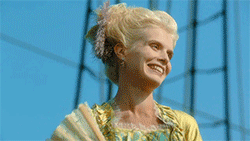
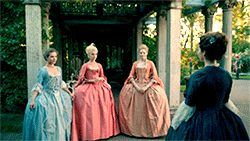
Sophie Dorothea of Württemberg (Maria Fyodorovna)
The second wife of Paul I was also a German princess. She is portrayed in the second season of the tv show Ekaterina, as well as in the tv series Adyutanty Lyubvy (Adjutants of Love) and the movie Bedniy Bedniy Pavel (Poor Poor Paul).
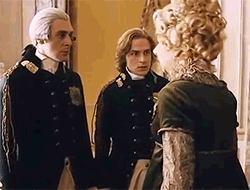
Louise of Baden (Elizaveta Alexeyevna)
Born a German princess, she was the wife of Alexander I of Russia. She is portrayed in the tv series Adyutanty Lyubvy (Adjutants of Love), Severniy Sfinks (Northern Sphinx) and the movie Bedniy Bedniy Pavel (Poor Poor Paul).
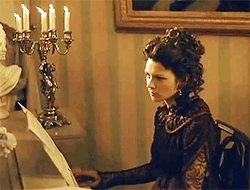
Friederike Luise Charlotte Wilhelmine von Preußen (Alexandra Fyodorovna)
She was the daughter of the Friedrich III (later became Nikolai I’s wife). She is portrayed in a couple of different tv shows, the most prominent of which is Bednaya Nastya (Poor Nastya), as well as in the movie The Captivating Star of Happiness.
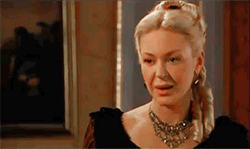
Maximiliane Wilhelmine Auguste Sophie Marie von Hessen (Maria Alexandrovna)
She was born a daughter of Ludwig II von Hessen (later married to Alexander II of Russia). She is portrayed in several tv shows, the more prominent of which are Bednaya Nastya (Poor Nastya) and Institut Blagorodnikh Devits (Institute for Noble Maidens).

Victoria Alix Helena Louise Beatrice von Hessen (Alexandra Fyodorovna)
Daughter of Louis IV of Hesse (married to Nikolai II). She is portrayed in a lot of stuff lol, the more well-known/accessible ones are probably: Nicholas and Alexandra (1971), Grigoriy R, Rasputin (1996), Rasputin (2011), Mathilde (2017).

25 notes
·
View notes
Photo
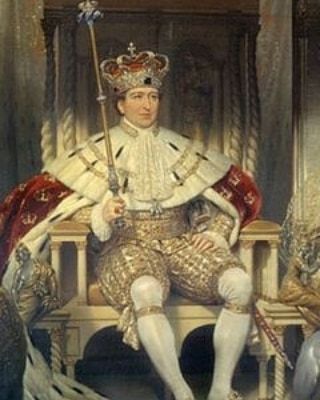
#OnThisDay År 1786, fødsel af kong Christian VIII af Danmark. også kendt som Christian Frederick I af Norge, var kongen af Norge fra februar til oktober 1814 (efterfølger Frederik VI og før Charles XIII) og konge af Danmark fra 1839 til 1848 (efterfølger Frederick VI og forud for Frederik VII. .christian blev født på Christiansborg Slot i København. Han var den ældste søn af arvelig prins Frederik af Danmark og Norge og hertuginde Sophia Frederica af Mecklenburg-Schwerin. .hans bedsteforældre var kong Frederik V af Danmark-Norge og hans anden kone, hertuginde Juliana Maria af Brunswick-Wolfenbüttel. Christian giftede sig først med sin fætter hertuginde Charlotte Frederica af Mecklenburg-Schwerin i Ludwigslust den 21. juni 1806 ..charlotte Frederica var datter af Friedrich Franz I, storhertug af Mecklenburg-Schwerin og prinsesse Louise af Saxe-Gotha-Altenburg (1756-1808). Hans førstefødte søn var Christian Frederik, som blev født og døde på Schloss Plön den 8. april 1807. Hans anden søn blev Frederik VII af Danmark. .ægteskabet blev opløst ved skilsmisse i 1810 efter Charlotte Frederica blev anklaget for utroskab.christian giftede sig med sin anden kone, prinsesse Caroline Amalie af Slesvig-Holsten-Sonderburg-Augustenburg (datter af Louise Augusta af Danmark, den eneste søster til Frederik VI) på Augustenborg Slot den 22. maj 1815 ..parret var barnløse og levede i komparativ pensionering som ledere i det litterære og videnskabelige samfund i København, indtil Christian besteg Danmarks trone. Kong Christian giftede sig først med sin fætter hertuginde Charlotte Frederica af Mecklenburg-Schwerin i Ludwigslust den 21. juni 1806. Ægteskabet blev opløst ved skilsmisse i 1810, efter at Charlotte Frederica blev anklaget for utroskab. Kong Christian giftede sig med sin anden kone, prinsesse Caroline Amalie af Slesvig-Holsten-Sonderburg-Augustenburg (datter af Louise Augusta af Danmark, den eneste søster til Frederik VI) på Augustenborg Slot den 22. maj 1815. Kong Christian døde af blodforgiftning i Amalienborg Slot i 1848 og blev begravet i Roskilde Domkirke. #DanishRoyalHistory #detdanskekongehus #detkongelige #KongChristianVIII #KingChristianVIII https://www.instagram.com/p/CT9PsHGvScV/?utm_medium=tumblr
1 note
·
View note
Photo

Those that have married in to the Royal Families since 1800
Denmark
Duchess Charlotte Frederica of Mecklenburg-Schwerin (4 December 1784 – 13 July 1840)
Charlotte was the first wife of King Christian VIII from 1806 until 1810, before he became King of Denmark. She was a daughter of Frederick Francis I, Grand Duke of Mecklenburg-Schwerin, and Princess Louise of Saxe-Gotha-Altenburg, the seventh of the couple's surviving children born at Ludwigslust's court.
On a visit to Mecklenburg Prince Christian Frederik of Denmark stayed at his uncle's court in Schwerin where he fell in love with his cousin, Duchess Charlotte, and two years later he married her. The young couple took residence first at Amalienborg royal complex, and partly at Sorgenfri, but married life was unhappy. Charlotte's character was thought to be capricious and frivolous. In 1808, she gave birth to her husband's only surviving son, the future King Frederick VII of Denmark. Charlotte Frederica's alleged affair with her singing teacher, Swiss-born singer and composer Édouard Du Puy, led on to her removal from the court. For this reason, her husband divorced her in 1810, sent her into internal exile in Horsens, and prohibited her from seeing her son again.
After her divorce, Charlotte Frederica spent the next years of her life in a palace in Horsens, in Jutland and partly in Aarhus, where she cultivated social circles among the local bourgeoisie and had affairs with officers. In 1829 she moved from Denmark to Karlsbad under the name "Mrs. von Gothen." In 1830 she traveled to Italy, finally settling in Rome and later converted to the Catholic faith. Charlotte Frederica died in Rome in 1840. Her death was no doubt a relief to the court in Copenhagen as she dreamed of someday returning as the King's mother. Frederik VII, who was only one year old when she had to leave him, showed great reverence towards the memory of his late mother: he collected portraits of her in his rooms at Jægerspris Castle, and when he visited Horsens on Sept. 1857 he officially thanked the city "for the love and kindness that was shown to her."
6 notes
·
View notes
Text
who: british line of succession
Succession to the British throne is determined by descent, gender, legitimacy, and religion. Under common law, the crown is inherited by an individual's children and by a childless individual's nearest collateral line. The Bill of Rights 1689 and the Act of Settlement 1701, both of them as amended in March 2015, restrict the succession to the legitimate Protestant descendants of Sophia of Hanover that are in "communion with the Church of England” (while marrying to Roman Catholics no longer disqualifies). Protestant descendants of those excluded for being Catholics are eligible to succeed.
The United Kingdom is one of the 16 Commonwealth realms. Each of those countries has the same person as monarch and the same order of succession. In 2011, the prime ministers of the realms agreed unanimously to adopt a common approach to amending the rules on the succession to their respective Crowns so that absolute primogeniture would apply for persons born after the date of the agreement, instead of male-preference primogeniture, and the ban on marriages to Roman Catholics would be lifted. The ban on Catholics themselves was retained to ensure that the monarch would be in communion with the Church of England. After the necessary legislation had been enacted in accordance with each realm's constitution, the changes took effect on 26 March 2015.
(source)
Current line of succession (as at 2015 and limited to the descendants of Elizabeth II)
HM Queen Elizabeth II (b. 1926) …..(1) HRH Charles, Prince of Wales (b. 1948) ……….(2) HRH Prince William, Duke of Cambridge (b. 1982) ……………(3) HRH Prince George of Cambridge (b. 2013) ……………(4) HRH Princess Charlotte of Cambridge (b. 2015) ……….(5) HRH Prince Henry of Wales (b. 1984) …..(6) HRH Prince Andrew, Duke of York (b. 1960) ……….(7) HRH Princess Beatrice of York (b. 1988) ……….(8) HRH Princess Eugenie of York (b. 1990) …..(9) HRH Prince Edward, Earl of Wessex (b. 1964) ……….(10) James, Viscount Severn (b. 2007) ……….(11) Lady Louise Windsor (b. 2003) …..(12) HRH Anne, Princess Royal (b. 1950) ……….(13) Peter Phillips (b. 1977) ……………(14) Savannah Phillips (b. 2010) ……………(15) Isla Phillips (b. 2012) ……….(16) Zara Tindall (b. 1981) ……………(17) Mia Tindall (b. 2014)
Note on members of the Royal House and Family of Mecklenburg:
The first King, Heinrich Ludwig I was a descendant of George II through his mother, and of George I through his father, with his mother having the superior claim. Heinrich Ludwig’s wife was also a descendant of George I but as a Roman Catholic, Karola was excluded from succession. Heinrich Ludwig lost his place in the line of succession following his marriage to a Roman Catholic. Heinrich Ludwig and Karola’s children were placed in the line of succession after their father as he had the superior claim.
The second King, Paul Friedrich II, married Duchess Thyra of Mecklenburg-Schwerin, a descendant of George III, with a more senior claim, therefore the children of Paul Friedrich and Thyra were placed in the line of succession after their mother.
The third King, Wilhelm Franz I, married Princess Eleonora of Leiningen, a descendant of Queen Victoria but as that descent is through the unapproved marriage of Princess Victoria Melita of Saxe-Coburg and Gotha to Grand Duke Kirill Vladimirovich of Russia, Eleonora cannot claim her place in the line of succession through that marriage. Instead, Eleonora is in the line of succession to the British throne as a descendant of Frederick, Prince of Wales. Wilhelm Franz has the more senior claim as descendant of George III and thus his children follow him in the line of succession.
The second son of Paul Friedrich II, Prince Albrecht Gustav, married Veronica Doncaster, who has no claim to the British throne and thus their children follow their father.
The eldest daughter of Paul Friedrich II, Princess Heinrike Franziska is unmarried and without issue.
The second daughter of Paul Friedrich II, Princess Elisabeth Mathilde, married Prince Rupprecht of Hohenlohe-Langenburg, a descendant of Queen Victoria and thus their children follow their father in the line of succession to the British throne. Princess Elisabeth Mathilde’s descendants have the most senior position of the Mecklenburgers in the British line of succession as they are descended from Queen Victoria’s second son, Alfred, Duke of Edinburgh and Saxe-Coburg and Gotha.
The third daughter of Paul Friedrich II, Princess Marie Anastasia, married Prince Heinrich of Hesse-Kassel, who had a more senior claim as a descendant of Queen Victoria through her eldest daughter, thereby the children of Marie Anastasia and Heinrich follow their father in the line of succession.
The fourth daughter of Paul Friedrich II, Princess Cecilie Auguste, married Hereditary Prince Michael of Schwarzburg, a descendant of George I of the United Kingdom. As Cecilie Auguste has a more senior claim as a descendant of George III, their children follow their mother in the line of succession.
Princess Marie Elisabeth, daughter of Heinrich Ludwig I, married Prince Gorm of Denmark, who also descended from George II but as Marie Elisabeth had the more senior claim, their children followed after her instead of him. Their grandchildren by their daughter, Feodora, are excluded from the British line of succession as they are Roman Catholic.
4 notes
·
View notes
Text
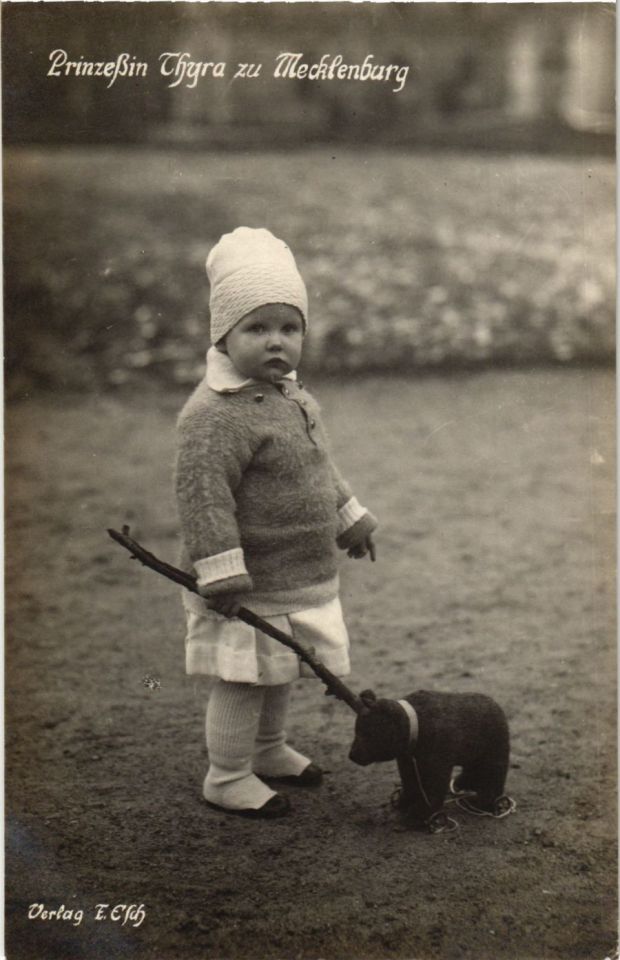
Duchess Thyra Anastasia Alexandrine Marie-Louise Olga Cecilie Charlotte Elisabeth Emma of Mecklenburg-Schwerin
German vintage postcard
#alexandrine marie-louise olga cecilie#tarjeta#postkaart#elisabeth emma#german#elisabeth#sepia#cecilie#historic#duchess#photo#mecklenburg#postal#briefkaart#emma#photography#anastasia#alexandrine#vintage#ephemera#ansichtskarte#charlotte#old#thyra#postcard#marie#louise#postkarte#schwerin#olga
4 notes
·
View notes
Text

Royals arriving in Gmunden for the wedding celebration of Grand Duke Frederick Francis IV of Mecklenburg-Schwerin and Princess Alexandra of Hanover and Cumberland, 1904.
From left to right: Prince Ernest Augustus of Hanover, Prince Maximilian of Baden, Prince Christian of Denmark, Princess Louise of Schaumburg-Lippe, Countess Sophie de Torby and Princess Heinrich XVIII Reuss of Köstritz.
#prince ernest augustus of hanover#king christian ix of denmark#prince maximilian of baden#princess louise of schaumburg-lippe#princess louise of denmark#countess sophie de torby#Princess Heinrich XVIII Reuss of Köstritz#duchess charlotte of mecklenburg-schwerin#1904#1900s
28 notes
·
View notes
Text
Magazine "Ueber Land und Meer" illustration depicting young German unmarried Princesses in 1895.
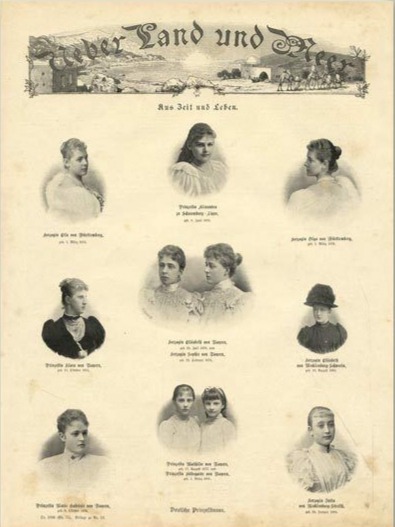
Back row: Duchess Elsa of Württemberg, Princess Alexandra of Schaumburg-Lippe and Duchess Olga of Württemberg.
Back row: Duchess Elsa of Württemberg, Princess Alexandra of Schaumburg-Lippe and Duchess Olga of Württemberg.
Middle row: Princess Clara of Bavaria, Duchesses Sophia Adelheid and Elisabeth in Bavaria, and Duchess Elisabeth Alexandrine of Mecklenburg-Schwerin.
Front row: Duchess Marie Gabrielle in Bavaria, Princesses Mathilde and Hildegarde of Bavaria and Duchess Jutta of Mecklenburg-Strelitz.
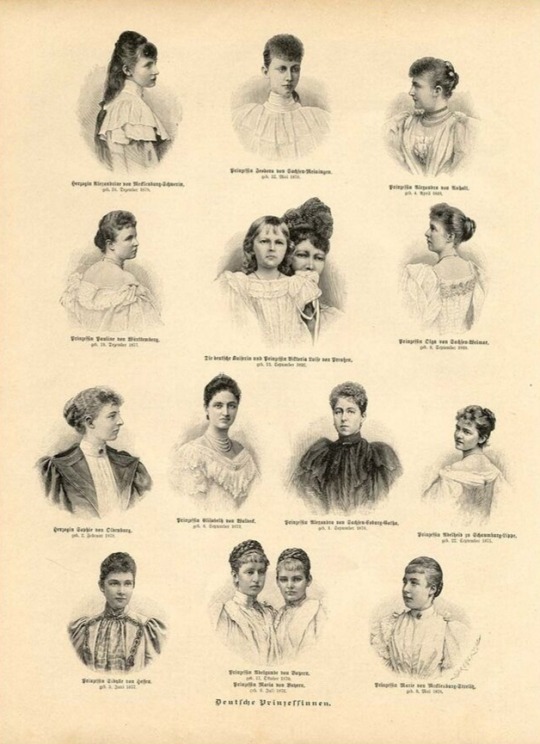
Back row: Duchess Alexandrine of Mecklenburg-Schwerin, Princess Feodora of Saxe-Meiningen and Princess Alexandra of Anhalt.
Middle row (1) Princess Pauline of Württemberg, German Empress Augusta Victoria with her daughter, Princess Victoria Louise of Prussia and Princess Olga of Saxe-Weimar-Eisenach.
Middle row (2): Duchess Sophia Charlotte of Oldenburg, Princess Elisabeth of Waldeck and Pyrmont, Princess Alexandra of Saxe-Coburg and Gotha and Princess Adelaide of Schaumburg-Lippe.
Front row: Princess Sybille Marguerite of Hesse, Princesses Adelgunde and Maria Ludwiga of Bavaria, and Duchess Marie of Mecklenburg-Strelitz.
#duchess olga of württemberg#duchess elsa of württemberg#duchess jutta of mecklenburg-strelitz#duchess marie of mecklenburg-strelitz#duchess alexandrine of mecklenburg-strelitz#duchess elisabeth alexandrine of mecklenburg-strelitz#duchess sophie adelheid in bavaria#duchess elisabeth in bavaria#duchess marie gabrielle in bavaria#princess adelgunde of bavaria#princess maria ludwiga of bavaria#princess clara of bavaria#princess mathilde of bavaria#princess hildegarde of bavaria#princess adelaide of schaumburg-lippe#princess alexandra of schaumburg-lippe#princess feodora of saxe-meiningen#princess olga of saxe-weimar-eisenach#princess victoria louise of prussia#princess alexandra of saxe-coburg and gotha#princess sybille marguerite of hesse#princess elisabeth of waldeck and pyrmont#duchess sophia charlotte of oldenburg#princess pauline of württemberg#german royalty#german royal#1895#1890s#german empress augusta victoria
37 notes
·
View notes
Text

Princess Louise Charlotte of Hesse-Kassel (1789-1864) née Denmark in 1860.
She was born in Christiansborg Palace to Frederick, Hereditary Prince of Denmark and Norway, and Sophia Frederica of Mecklenburg-Schwerin.
On 10 November 1810 in Amalienborg Palace she married Prince William of Hesse-Kassel. Her spouse was in Danish service from his youth, and the family lived in Denmark.
Princess Charlotte was described as a wise, practical and thrifty, and kept the finances of her household under strict control. She had some interest in art and poetry, and reportedly felt herself to be a Danish patriot. Charlotte played some part in the succession crisis which occurred because her cousin, King Frederick, lacked a male heir. She supported the solution that her branch of the family should succeed to the throne, and because of this, she opposed the Schleswig-Holstein matter
In 1839, her brother Christian VIII of Denmark succeeded their cousin on the throne, and during his reign, Charlotte had an important position at the Danish royal court in Copenhagen because her brother favored that her line of the family should succeed to the throne after his male line had died out.
In 1848, her brother died and was succeeded by his childless son, her nephew. In 1850, the Danish government was pressured by the Empire of Russia to discontinue its support of her line in the succession order in favor of the Duke of Oldenburg, her son-in-law. Christian of Oldenburg had displayed anti-Danish sentiment during the recent war, and when gehejmeråd F.C. Dankwart, on behalf of the government, issued the demand that she should renounce her and her son's right to the throne in favor of her son-in-law, she replied: "It is impossible: the Danish people would under no circumstance accept as King a Prince from a house that has made war against Denmark, and that is so hostile toward us". In exchange, she demanded that the House of Oldenburg purchase the Duchy of Hesse and declare it a kingdom, so that her son Frederick could "Switch one Kingdom for another". After having been persuaded that her terms were impossible and that Christian of Oldenburg in fact had good support for his claim, she agreed to renounce her and her son's claims to the throne.
On 18 July 1851, she and her son Frederick renounced their claims to the Danish throne in favour of her daughter Louise, who in turn renounced it in favour of her spouse.
Louise Charlotte is the matrilineal great-grandmother of Nicholas II of Russia, William IV, Grand Duke of Luxembourg and George V.
She died in Christiansborg Palace.
#Princess Charlotte of Denmark#princess charlotte of hesse-kassel#danish royal#danish royalty#danish royal family#danish#hesse-kassel#1860
18 notes
·
View notes
Text
Master Post - Members by birth
Disclaimer: Houses that rule(d)/reside(d) in other countries but originally came from German and/or Austrian territories and/or are generally regarded as belonging to this cultural room are listed among the German & Austrian Houses.
German & Austrian Houses
House of Ascania
Princess Sophie of Anhalt-Zerbst aka Catherine the Great
House of Coburg (Cadet branch of the House of Wettin)
Princess Alice of the United Kingdom, The Grand Duchess of Hesse and by Rhine
Princess Antoinette of Saxe-Coburg-Saalfeld, Duchess of Württemberg
Princess Charlotte of Belgium, The Empress of Mexico, Archduchess of Austria
Princess Stéphanie of Belgium, Crown Princess of Austria, Hungary & Bohemia
Princess Victoria of Great Britain and Ireland, Princess Royal, The German Empress
Victoria of Saxe-Coburg-Saalfeld, The Princess of Leiningen, The Duchess of Kent
House of Griffin
Elizabeth of Pomerania, Holy Roman Empress
House of Habsburg
Archduchess Johanna of Austria, The Grand Duchess of Tuscany
Archduchess Maria Amalia of Austria, Holy Roman Empress, The Electress of Bavaria
Archduchess Maria Anna of Austria, Princess of Lorraine and Bar
Archduchess Maria Antonia of Austria, The Electress of Bavaria
Archduchess Maria Antonia “Marie Antoinette” of Austria, The Queen of France and Navarre
Archduchess Maria Leopoldine of Austria, The Empress of Brazil, Queen of Portugal & the Algarves
Maria Theresia, The Archduchess of Austria, Holy Roman Empress
Archduchess Sophie of Austria
House of Hanover (Cadet branch of the House of Welf)
Princess Sophia Dorothea of Hanover, The Queen in Prussia
Queen Victoria of the United Kingdom, Empress of India
House of Hesse
Princess Alix of Hesse and by Rhine, Empress Alexandra Feodorovna of Russia
Princess Elisabeth of Hesse and by Rhine, Grand Duchess Elizabeth Feodorovna of Russia
House of Hohenlohe-Langenburg
Princess Adelheid of Hohenlohe-Langenburg, The Duchess of Schleswig-Holstein
Princess Feodora of Hohenlohe-Langenburg, The Duchess of Saxe-Meiningen
House of Hohenstaufen
Elisabeth “Beatrix” of Swabia, The Queen of Castile, León & Galicia
Konstanze “Anna” of Hohenstaufen, The Empress of Nicaea
House of Hohenzollern
Princess Anna Amalia of Prussia
Princess Caroline of Ansbach, The Queen of Great Britain & Ireland, The Electress of Hanover
Princess Elisabeth of Brandenburg, The Duchess of Brunswick-Calenberg-Göttingen
Princess Luise of Prussia, Princess Radziwiłł
Princess Maria Eleonora of Brandenburg, The Queen of Sweden
Princess Marie of Prussia, The Queen of Bavaria
Princess Wilhelmine of Prussia, The Margravine of Brandenburg-Bayreuth
House of La Marck
Amalia of Cleves
Anne of Cleves, The Queen of England
Sybille of Cleves, The Electress of Saxony
House of Leiningen
Princess Feodora of Leiningen, The Princess of Hohenlohe-Langenburg
House of Liechtenstein
Princess Sophie of Liechtenstein, Countess Esterházy de Galantha
House of Mecklenburg
Charlotte of Mecklenburg-Strelitz, The Queen of Great Britain, Ireland & Hanover
Elisabeth of Mecklenburg-Schwerin, Princess of Brunswick-Lüneburg aka Grand Duchess Anna Leopoldovna of Russia
Friederike (Federica) of Mecklenburg-Strelitz, The Queen of Hanover
Louise of Mecklenburg-Strelitz, The Queen of Prussia
Therese of Mecklenburg-Strelitz, The Princess of Thurn and Taxis
House of Northeim
Richenza of Northeim, Holy Roman Empress
House of Oldenburg
Augusta Victoria of Schleswig-Holstein, German Empress
Princess Cecilie of Greece & Denmark, The Hereditary Grand Duchess of Hesse and by Rhine
House of Reuß
Princess Hermine Reuß of Greiz, “German Empress”
House of Thurn and Taxis
Princes Marie Auguste of Thurn and Taxis, Duchess of Württemberg
House of Welf
Adelaide of Burgundy, Holy Roman Empress, Queen of Italy
Princess Caroline of Brunswick-Wolfenbüttel, The Queen of the United Kingdom & Hanover
Elisabeth Christine of Brunswick-Wolfenbüttel, Holy Roman Empress
Elisabeth Christine of Brunswick-Wolfenbüttel-Bevern, The Queen in & of Prussia
Princess Juliane of Brunswick-Wolfenbüttel-Bevern, The Queen of Denmark and Norway
House of Wettin
Adelheid (Adelaide) of Saxe-Meiningen, The Queen of the United Kingdom and Hanover
Princess Augusta of Saxe-Weimar-Eisenach, German Empress
Princess Christina of Saxony, The Landgravine of Hesse
Princess Luise (Louise) of Saxe-Gotha-Altenburg, The Duchess of Saxe-Coburg-Saalfeld, The Countess of Pölzig and Beiersdorf
House of Wied-Neuwied
Princess Elisabeth of Wied, The Queen & Princess of Romania
House of Wittelsbach
Princess Alexandra of Bavaria
Princess Amalie Auguste of Bavaria, The Queen of Saxony
Eleonore Magdalene of Neuburg, Holy Roman Empress
Elisabeth “Sisi” in Bavaria, The Empress of Austria
Elisabeth (Isabeau) of Bavaria, The Queen of France
Princess Elisabeth Ludovika of Bavaria, The Queen of Prussia
Helene “Néné” in Bavaria, The Hereditary Princess of Thurn and Taxis
Princess Ludovika of Bavaria, The Duchess in Bavaria
Princess Maria Anna of Bavaria, The Archduchess of Inner Austria-Styria
Princess Maria Anna of Bavaria, The Queen of Saxony
Marie in Bavaria, The Queen of Two Sicilies
Baroness Marie Louise of Wallersee, Countess of Larisch
Mathilde in Bavaria, The Countess of Trani
Sophie in Bavaria, The Duchess of Alençon
Princess Sophie of Bavaria, Archduchess of Austria
House of Württemberg
Mary of Teck, The Queen of the United Kingdom & British Dominions, Empress of India
Princess Sophie of Württemberg, The Queen of the Netherlands
Minor Nobles
Anna Constantia of Brockdorff, The Imperial Countess of Cosel
Katharina von Bora, Mrs Martin Luther
Baroness Louise Lehzen
Baroness Marie “Mary” of Vetsera
Sophie Botta, The Dark Countess of Hildburghausen
Sophie of Pannwitz, Countess of Voß
Foreign Houses
House of Albret
Jeanne d’Albret, The Queen of Navarre, 1. The Duchess of Jülich-Cleves-Berg and 2. The Duchess of Vendôme
House of Aviz
Infanta Eleonor of Portugal, Holy Roman Empress
House of Bourbon
Princess Louise d’Orléans, Princess Alfons of Bavaria
Byzantine Imperial Family
Princess Eudokia Laskarina of Nicaea, The Hereditary Duchess of Austria
Irene of Byzantium, The Queen of the Germans, The Duchess of Swabia
Princess Theodora Angelina, The Duchess of Austria & Styria
Princess Theodora Komnene of Byzantium, The Duchess of Bavaria & Austria
Theophanu, Holy Roman Empress
House of Chotek
Countess Sophie Chotek of Chotkowa and Wognin, The Duchess of Hohenberg
House of Este
Maria Beatrice d’Este, The Duchess of Massa & Carrara, Archduchess of Austria
House of Jagiellon
Jadwiga (Hedwig) Jagiellon, The Electress of Brandenburg
House of Stuart
Elizabeth Stuart, The Queen of Bohemia & Electress Palatine
House of Trastámara
Queen Joanna “The Mad” of Castile, Léon & Aragon, The Duchess of Burgundy, Archduchess of Austria
House of Valois
Mary, The Duchess of Burgundy, Archduchess of Austria
Commoners
Fatima Kariman aka Maria Aurora (von) Spiegel
Helene Baltazzi, The Baroness of Vetsera
Louise Rump, Mrs Ebert
Margot Großmann, Mrs Sauerbruch
Maria Anna Mozart, The Imperial Baroness Berchthold
Maria “Mizzi” Kaspar
Ottilie Richter, Baroness of Faber
Sophie Scholl
36 notes
·
View notes